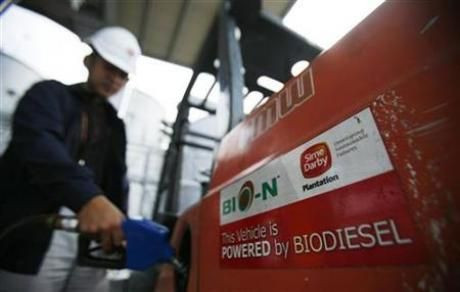National Biodiesel Day: Interesting Facts About The Alternative Fuel
KEY POINTS
- March 18 marks National Biodiesel Day
- Biodiesel is a biodegradable and renewable alternative fuel
- It can be produced from used cooking oil and soybeans
It's National Biodiesel Day on March 18, an occasion to celebrate the alternative fuel that has been gaining ground across the world.
The day commemorates the birthday of Rudolf Diesel, the man who invented the diesel engine. Diesel unveiled his invention at the World Fair in 1900, National Day Calendar said. While speaking at a function in 1912, Diesel said, "vegetable oils for engine fuels may seem insignificant today, but such oils may become, in the course of time, as important as petroleum and the coal-tar products of the present time."
Sure enough, more and more people are using biodiesel to power their vehicles today. But exactly what is it?
According to the U.S. Department of Energy's Alternative Fuels Data Center (AFDC), biodiesel is a domestically-produced, renewable and cleaner substitute for petroleum diesel. It can be made from sources such as animal fat, recycled cooking oil or, as Diesel expected, vegetable oil.
It is said to be non-toxic and biodegradable compared to petroleum diesel, the U.S. Energy Information Administration (EIA) explained, noting that the U.S. government considers biodiesel to be carbon neutral.
On this day, let's have a look at some important facts about biodiesel to learn a little bit more about this alternative fuel.
It's locally produced
Biodiesel helps lessen the country's dependence on imported fuels because it can be locally made, which means reduced transportation cost, increased energy security and more jobs, the AFDC said.
Every country that produces biodiesel locally can enjoy these benefits.
Better for the environment
According to the EIA, biodiesel is "much cleaner" compared to petroleum diesel.
"Compared to petroleum diesel fuel, which is refined from crude oil, biodiesel combustion produces fewer air pollutants such as particulates, carbon monoxide, sulfur dioxide, hydrocarbons, and air toxics," the EIA said. "Nitrogen oxide emissions from burning a gallon of biodiesel may be slightly higher than emissions from burning a gallon of petroleum diesel."
Safer than petroleum
In its "pure, unblended form," biodiesel is considered to be safer than petroleum diesel since it's less combustible.
"The flashpoint for biodiesel is higher than 130°C, compared with about 52°C for petroleum diesel," the AFDC said.
This makes it safer to store, handle and transport.
Some negative effects
Although biodiesel does have a lot of benefits, its environmental impact is quite complicated. According to EIA, the carbon emissions released while producing biodiesel are offset by the carbon dioxide absorbed by the plants used to make it, making it carbon neutral.
However, the way the land is used to grow these plants makes it a little more complicated. This is because, in some places, natural vegetation gets burned and cleared out to make way for such plants.
"The negative environmental effects of this land clearing and burning may be greater than the potential benefits of using biodiesel produced from soybeans and palm oil trees," the EIA said.
Impact cycle
The International Council on Clean Transportation (ICCT) also noted the odd cycle that happens when people use cooking oil to make biofuels. This is because in the U.S., used cooking oil is often used in livestock feed. Using it to make biofuel would mean people will have to look for something else to feed the animals. This, in turn, may lead to further land use.
Making it more environment-friendly
Scientists are looking at other materials that may be used to make biofuel without the potential environmental impacts, National Geographic said. This includes wood waste, algae, wastewater sludge and other plant materials that have no other uses.

© Copyright IBTimes 2025. All rights reserved.






















